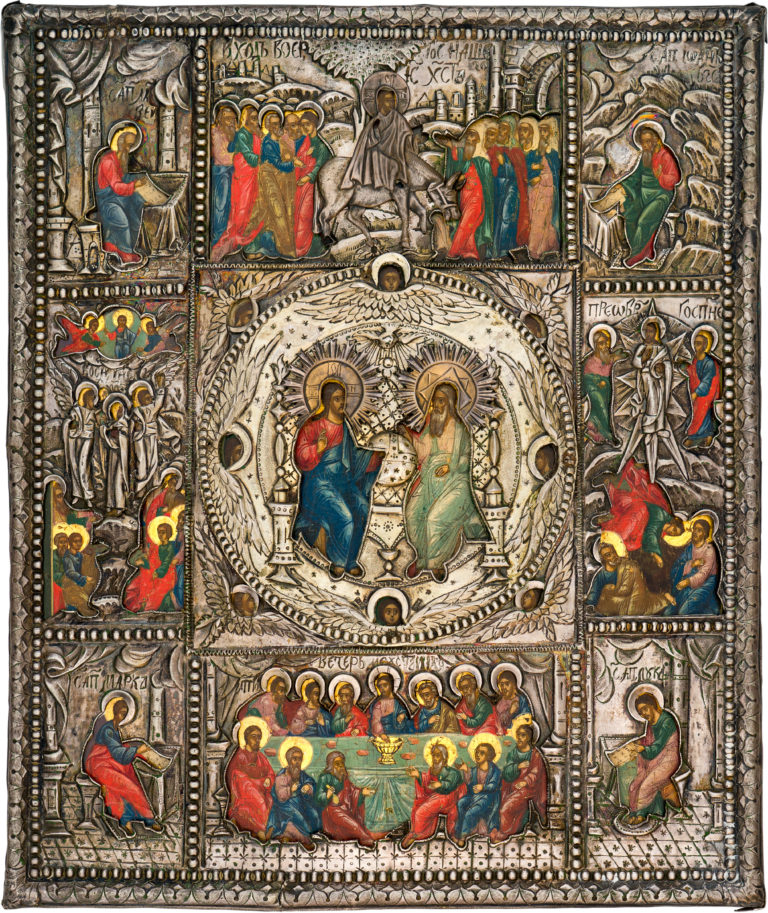The New Testament Trinity, with Selected Church Feasts and the Four Evangelists
Antique Russian icon: early 19th century. Central Russia. Oklad cover: 1814. St. Petersburg.
Size: 35 х 29 х 2 cm
Wood (three panels), two incut support boards, absence of the incut centerpiece, underlying layer of canvas not visible, gesso, tempera. Oklad cover: silver, etching, engraving.
Brands on the oklad cover: St. Petersburg coat-of-arms with the year “1814;” assayer’s brand “84;” and the lettering “A.Я.” as the master’s hallmark.
The author’s paintwork is well preserved with only slight chafing of the surface and small fallouts. The left field of the antique icon contains a restoration insertion. The surface of the oklad cover is slightly darkened, the relief is a bit worn. In its lower part, there is a crack in the metal.
Contact us

The New Testament Trinity, with Selected Church Feasts and the Four Evangelists
Diagram of the border scenes:
- The Evangelist Matthew;
- The Entrance into Jerusalem;
- The Evangelist John the Theologian;
- The Ascension;
- The Transfiguration;
- The Evangelist Mark;
- The Last Supper;
- The Evangelist Luke.
The iconography, known among religious icon art historians as the New Testament Trinity (unlike the Old Testament Trinity, with the Three Angels and the Hospitality of Abraham), is a depiction of the Triune God. It has two variations: “The Fatherhood,” where Christ is shown as a youth sitting on the lap of God Sabaoth, and “The Enthronement” iconography, where the Father and the Son sit side by side on a throne, on both sides of a sphere crowned by a cross, with the Holy Spirit floating in the air in the likeness of a dove. The given antique Russian icon belongs to the second type. In the 16th century, this variation of Eastern Orthodox icons was called by the first words of the Paschal Troparion, “In the Tomb lying in the Flesh;” “On the Throne You sat with the Father and the Holy Spirit.” These words were taken from Psalm 109/110, “And the Lord said to my Lord sit upon my right hand, as I lay your enemies before your feet.” In the Imperial period, such hand-painted Orthodox icons, popular among the Old Believers, were known as “The Triune God.” This variation was formed in the 16th century, probably as part of the Eastern Orthodox iconography of the Last Judgment. Later, the image was included into the holy icons of the Creed and the Sabbath of All Saints. Russian religious icons bearing this version of the New Testament Trinity (The Enthronement) surrounded by border scenes with selected Feasts are quite rare and known only since the end of the 17th century. The selection of border scenes was probably established by the commissioner – a member of the Old Believers. This is indicated to by the “two-finger” sign of the cross and the titles over Christ «IC XC.»
The artistic traits of the given antique Russian icon are somewhat dualistic, which is typical for the 18th-19th century transition period. The bright color scheme reflects the Baroque style, while the overall light tone, the local color combinations, the ordered composition, and the rather dry execution of the vestments and movements were obviously tied to Classicism.
The silver riza or oklad cover was made in 1814 and belongs to “picturesque” or “artistic” movement among the ecclesiastical jewelers of Imperial Russia. The oklad does closely follow the art of the iconographer, becoming in itself an embossed religious icon. Its execution reflects the traits of the early Empire style – the structural clarity, the detailed décor, and the thin pearl-ornamented frames that separate the border scenes. The smooth surface of the metal bears the embossed depictions of the landscape and architecture. The great artistry of the silversmith is attested to by the relief embossing and line-etching that create light reflexes and unique rhythm of the light. The borders of the frame rise above the overall surface and are decorated with palmette ornamentation, which is typical for the early 19th century. The characteristic traits of Empire style oklad covers are the votive crowns surrounded by heavenly light. In this case, they can be seen in the centerpiece of the antique Russian icon.